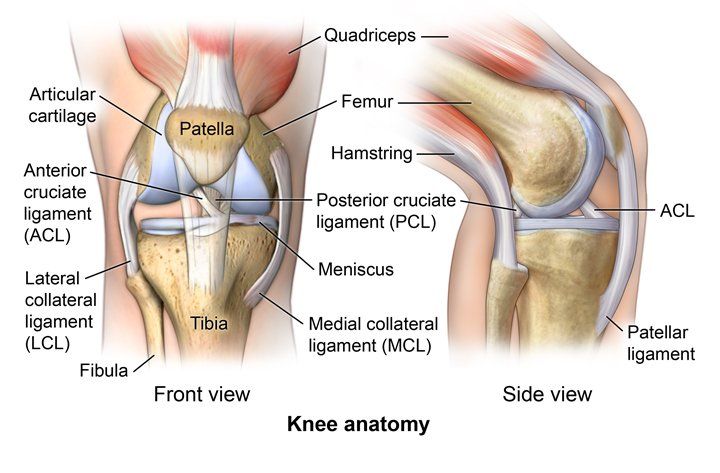KNEE
Ligament Injuries
The knee is a complex joint where the femur (thighbone), tibia (shinbone) and patella (kneecap) meet.
The kneecap sits in front of the joint to provide some protection. The knee is connected by ligaments which act like strong ropes to hold the bones together and keep the knee stable. Tendons connect the knee bones to the leg muscles that move the knee joint, and cartilage provides separation and a protective cushion between the femur and tibia.
Injuries to ligaments can be graded depending on the severity of injury.
- Grade I: the ligament is mildly damaged and slightly stretched, but the knee joint is stable.
- Grade II: the ligament has been stretched to a point where it becomes loose and there is a partial tear.
- Grade III: the ligament has been torn or directly pulled off the bone and there is a complete tear resulting in an unstable knee joint.

PCL Rupture
The Posterior Cruciate Ligament (PCL) is one of the four major ligaments connecting the femur to the tibia. It is located within the back of the knee and is larger and thicker than the ACL, therefore requiring larger forces to cause injury.
The PCL is usually injured by direct impact. Common causes include falling onto a bent knee, sporting injuries and motor vehicle accidents. Injury to this ligament is common compared to ACL rupture.
MCL Rupture
The Medial Collateral Ligament (MCL) is located on the inner aspect of the knee connecting the femur to the tibia and acts to control sideways movement. A common knee injury, MCL rupture occurs when the knee is forced inwards into an excessive ‘knocked knee’ position. MCL injuries are common in various sports, especially soccer, AFL, netball, rugby, netball and basketball.
Symptoms
Depending on which ligament is injured, the location of symptoms will vary. When the cruciate ligament is damaged there will be pain at the sides of the knee. If there is an MCL injury pain will be on the inside, whereas a lateral cruciate ligament (LCL) injury will lead to pain on the outside of the knee. Whereas injury to the PCL requires a lot of force and is usually associated with an acute painful episode. For any ligament injury there will also be swelling, instability and difficulty weight bearing.
Diagnosis
Ligament injuries are usually suspected following comprehensive examination of clinical history and physical examination of manipulating the knee and leg bones. Diagnosis is confirmed with imaging. An MRI will show any damage done to the injured ligament or damage to surrounding soft tissue structures in the knee (including other ligaments, cartilage, menisci and bone). X-ray may also be requested to rule out other problems in the knee with similar symptoms or if the injury is associated with fracture.
Treatment Options
Non Operative Treatment
Most isolated ligament injuries can often be managed without surgery. Dr du Sart may recommend a period of knee bracing and possibly crutches. It is important to initiate the R.I.C.E. method to help treat and prevent excessive swelling:
- Rest the knee to prevent further damage and pressure on the injury.
- Ice packs can be applied to the injured area to reduce swelling and pain. Ensure to wrap the ice in a towel and apply to the affected area for 15-20 minutes, four times a day for several days.
- Compression on the knee by wrapping it with an elastic bandage or compression stocking can help minimise swelling and support the knee.
- Elevate the knee above heart level to help reduce swelling and pain.
A physiotherapy rehabilitation program may also be beneficial to help achieve function of the knee.
Surgery
If the collateral ligament is torn in a way that can not be healed (for example high-grade injuries) or is associated with other ligament injuries, surgery may be suggested to repair it.
When non-operative treatment of the PCL rupture has failed or when the injury is severe and associated with significant joint laxity, surgery may be recommended. PCL reconstruction is performed where a tendon graft is taken from another part of the body to replace the injured PCL.
Every patient's injuries and circumstances vary, ligament injuries are complex and require an individual approach to treatment. Dr du Sart will discuss your injury and treatment options with you at your appointment.

© All rights reserved
For all appointments and enquiries please contact us on:
Phone: 08 9779 9767
Email: admin@ryandusart.com.au
Address: 6 Higgins St, South Bunbury, 6230
